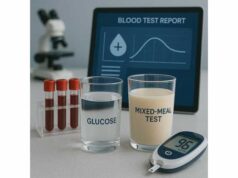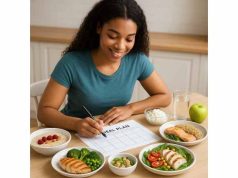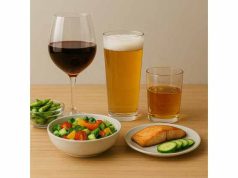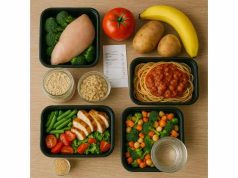
You do not need a different menu every day to make progress—you need a repeatable system that fits busy weeks. This 30-day template uses a one-week loop you can repeat four times with small swaps. You will set a realistic calorie range, anchor each meal with protein and fiber, and batch-cook once or twice per week so weekdays feel automatic. If you want a quick refresher on calories, macros, and how to pace weight loss safely, start with our concise guide to nutrition foundations for weight loss. Then come back here and plug your numbers into the templates, shopping lists, and make-ahead steps below.
Table of Contents
- How this 30-day template works
- Build your weight loss meal plan: calories and protein
- The one-week loop to repeat
- Breakfast options: pick two
- Lunches that travel well
- Family-friendly dinners that scale
- Troubleshooting plateaus and special cases
- Frequently Asked Questions
How this 30-day template works
A 30-day plan that works in real life is simple, modular, and repeatable. Instead of 30 unique recipes, you will cycle a 7-day framework four times, adjusting flavors and sides to keep it interesting without adding decision fatigue.
What stays constant
- Protein anchor at every meal. Aim for ~30–40 g at breakfast, ~35–45 g at lunch, and ~35–50 g at dinner. Snacks bridge gaps.
- Fiber and volume. Include fruit, vegetables, beans, or intact grains to reach 25–38 g/day of fiber.
- Balanced plate. Half non-starchy veg, a palm or more of protein, a cupped hand of quality carbs, and a thumb of added fat.
- Meal timing you can repeat. Most people do well on 3 meals + 1 snack or 2 meals + 2 snacks, depending on schedule.
What rotates weekly
- Flavors and sides (e.g., Mexican week vs. Mediterranean week).
- Carb sources (potatoes, rice, barley, whole-grain pasta).
- Proteins (chicken, fish, tofu, eggs, lean beef, lentils).
- Vegetables based on price and season.
Your weekly rhythm
- Friday/Saturday (30–45 minutes): grocery run and one batch cook (protein + grain + vegetables).
- Sunday (20 minutes): portion lunches, prep vegetables, mix grab-and-go snacks.
- Weekdays (10–20 minutes/day): assemble from prepped components.
Why repetition wins
- Consistency beats novelty. The same breakfast and lunch on weekdays removes portion guesswork.
- Budget control. Bulk purchases get used up across all four weeks.
- Less waste, more accuracy. You learn true portions for your goals.
Expected results
Set a modest deficit and you can expect 0.3–1.0% of body weight lost per week on average. Use a weekly average on the scale and waist measurement to judge progress, not any single day. For a quick safety overview while you calibrate pace, read our guide to safe weight loss basics.
What you will not do
- No detoxes, banned foods, or “cheat days.”
- No complicated macros at every meal.
- No cooking for an hour every night.
You will eat real food, plan once, and let the system run.
Build your weight loss meal plan: calories and protein
Set your daily calories and protein first—everything else plugs into those numbers. This keeps meals satisfying and your weekly deficit intact.
Step 1: Pick a calorie range you can live with
- Choose a target that creates a modest deficit (often 300–600 calories/day for many adults).
- Use a range rather than a single number (e.g., 1,700–1,900). This preserves sanity on busier days.
- If you are unsure where to start—or want a quick check against your size and activity—use our short explainer on setting a daily calorie target.
Sanity checks
- Hunger is present but manageable; energy is good; training feels normal.
- If you are ravenous at night, shift more calories to breakfast/lunch and increase protein.
Step 2: Set protein
- Aim for 0.7–1.0 g per pound of goal body weight (or 1.6–2.2 g/kg) per day.
- Split across meals so each one delivers 25–45 g.
Easy anchors per serving
- 200–250 g Greek yogurt or skyr: ~20–25 g
- 150 g cottage cheese: ~20–25 g
- 120–150 g cooked chicken or turkey: ~30–40 g
- 150–200 g firm tofu or tempeh: ~20–35 g
- 2 eggs + 150 g egg whites: ~28–32 g
- 1 scoop whey/soy isolate (20–30 g): ~20–30 g
Step 3: Fill the plate with carbs and fats that support satiety
- Carbs: emphasize oats, potatoes, rice, beans, fruit, whole-grain breads.
- Fats: olive oil, avocado, nuts, seeds, tahini—measured. Use 1–2 teaspoons oil when cooking and 1 tablespoon nuts/seeds per meal as a default.
Step 4: Choose your weekly pattern
Pick one of these and hold it for the month:
- Three meals + one snack (most people).
- Two meals + two snacks (if mornings are hectic).
- Early training days: a small pre-workout carb (toast/banana) plus a protein-forward breakfast after.
Step 5: Put numbers into a simple template
- Breakfast: 30–40 g protein + 20–45 g carbs + fruit/veg
- Lunch: 35–45 g protein + 40–60 g carbs + vegetables
- Snack: 15–25 g protein + fruit/veg
- Dinner: 35–50 g protein + 40–70 g carbs + vegetables
This architecture scales to higher or lower calories by adjusting carb portions and added fats while keeping protein steady.
The one-week loop to repeat
Here is the 7-day framework you will repeat four times. Keep breakfasts and lunches mostly the same on weekdays; vary dinners within a theme so your family stays interested and you stay on budget.
Your make-ahead base (weekend)
- Protein batch (choose one):
- 1.2–1.5 kg chicken thighs or breasts, roasted and sliced
- 1.0 kg extra-firm tofu, pressed and baked
- 1.2 kg lean ground turkey or beef, browned with onions and spices
- Grain/potato batch (choose one):
- 6–8 cups cooked rice, barley, or quinoa
- 1.5–2.0 kg roasted potatoes, wedges, or cubes
- Vegetable tray:
- Roast a full sheet pan of mixed vegetables or keep a raw “salad box” (shredded cabbage, carrots, peppers, cucumbers).
- Sauces (two small jars):
- Yogurt-tahini-lemon
- Salsa verde or pico de gallo
For a streamlined weekend routine with timing and sequencing, see our one-hour weekend plan and adapt the quantities above.
Weekday pattern (Mon–Fri)
- Breakfast: choose one of the sets from the breakfast section and repeat it.
- Lunch: assemble from your base (protein + grain + vegetables + sauce).
- Snack: yogurt + fruit, cottage cheese + tomatoes, or a protein shake + apple.
- Dinner: rotate three easy dinners and two “assembly” nights (e.g., tacos/bowls).
Sample week (calibrated for ~1,800–2,000 calories; adjust portions)
- Mon:
- Breakfast: Greek yogurt bowl (oats, berries, chia)
- Lunch: chicken + rice bowl with roasted veg, salsa
- Snack: cottage cheese + pineapple
- Dinner: sheet-pan salmon, potatoes, green beans
- Tue:
- Breakfast: egg + egg white scramble, toast, fruit
- Lunch: tofu + quinoa bowl, tahini sauce
- Snack: protein shake + banana
- Dinner: turkey taco bowls (beans, rice, salsa, slaw)
- Wed:
- Breakfast: overnight oats with skyr and berries
- Lunch: chicken + barley + vegetables, lemon yogurt sauce
- Snack: yogurt + granola sprinkle
- Dinner: quick pasta with lean beef, tomato sauce, big side salad
- Thu:
- Breakfast: cottage cheese toast with tomatoes, olive oil teaspoon
- Lunch: lentil-veg bowl, feta, olives (measure)
- Snack: apple + peanut butter teaspoon
- Dinner: stir-fry (shrimp or tofu) with rice and frozen veg mix
- Fri:
- Breakfast: protein oatmeal (whisk in whey off heat)
- Lunch: leftovers bowl
- Snack: carrots + hummus
- Dinner: freezer night—burrito bowls from prepped components
- Sat/Sun: similar breakfasts; lunches from leftovers or simple sandwiches; one flex dinner out.
Shopping blueprint (per week, adjust for household)
- Proteins: 1.2–1.5 kg lean meat or tofu; 18 eggs; 1–2 tubs Greek yogurt; 1–2 blocks cottage cheese; canned beans or lentils
- Carbs: oats; 2–3 kg potatoes; 1–2 kg rice/barley/quinoa; whole-grain bread or tortillas
- Produce: 1.5–2.5 kg mixed vegetables; salad greens; 1–2 kg fruit (berries, apples, bananas)
- Fats and flavor: olive oil, nuts/seeds, tahini, salsa, spices, lemons/limes
Repeat the loop for Weeks 2–4. Change the protein (e.g., chicken → tofu), the grain (rice → barley), and the sauce profile (salsa → yogurt-tahini) to keep meals fresh with minimal extra effort.
Breakfast options: pick two
Pick two weekday breakfasts and repeat them. This keeps mornings fast and portions predictable. Each option below lands near 30–40 g protein with fiber.
Five-minute builds
- Greek yogurt power bowl: 250 g Greek yogurt, ½ cup oats, 1 cup berries, 1 tablespoon chia.
- Egg + whites wrap: 2 eggs + 150 g egg whites with spinach and salsa in a high-fiber tortilla.
- High-protein chia pudding: chia soaked in milk; fold in 200 g skyr; top with fruit.
- Cottage cheese toast: 200 g cottage cheese on whole-grain toast with tomatoes and pepper; olive oil teaspoon.
- Protein oatmeal: cook oats with milk; whisk in 20–25 g whey or soy isolate off heat; add banana.
Make-ahead jars (4 at a time)
- Overnight oats base: oats + milk + chia. In the morning add 150–200 g Greek yogurt and fruit.
- Savory yogurt bowls: yogurt + cucumbers + tomatoes + lemon; add toast or boiled potatoes on the side.
Portioning without tracking
- Protein = palm to palm-and-a-half.
- Oats/cooked grains = ½–1 cupped hand.
- Fruit = one fist.
- Oils/nut butters = one thumb (1 teaspoon) unless training early.
If you train early
- Before: toast or banana + 20–25 g protein (small shake or yogurt).
- After: one of the breakfasts above with a bit more carb.
For more quick ideas you can cycle through without changing calories much, see our roundup of high-protein breakfast ideas and plug them into your two-option rotation.
Lunches that travel well
Great lunches are assembly meals: protein + grain or potato + big vegetables + sauce. Prep four bowls on Sunday; keep the fifth flexible for leftovers or a team lunch.
Bowl formulas (choose one per week and repeat)
- Southwest bowl: chicken or tofu + rice + black beans + roasted peppers + salsa.
- Mediterranean bowl: turkey or chickpeas + barley + cucumber/tomato salad + yogurt-tahini.
- Stir-fry bowl: shrimp or tempeh + rice + stir-fried frozen veg + soy-ginger.
- Pasta salad bowl: whole-grain pasta + tuna + cherry tomatoes + spinach + light vinaigrette (measure).
Sandwich rotation (if a bowl is not practical)
- High-protein yogurt chicken salad on whole-grain bread with crunchy veg.
- Turkey + cottage cheese spread, tomato, lettuce; fruit on the side.
- Hummus + egg with arugula in a high-fiber wrap.
Pack like a pro
- Use leakproof containers; keep sauces separate until lunch.
- Add a crunch factor (shredded cabbage, cukes) to increase volume for almost no calories.
- Keep an office kit: salt, pepper, chili flakes, light vinaigrette, hot sauce.
If you work on the road
- Carry shelf-stable milk, a scoop of protein powder, high-fiber tortillas, and tear-open tuna or bean pouches. Ten minutes in a car or break room is enough to assemble a satiating lunch.
For more portable combinations and pre-portion ideas, browse our list of packable, make-ahead lunches and plug two into your weekly loop.
Family-friendly dinners that scale
Dinners succeed when they are fast, flexible, and familiar. Use the “main + base + veg + sauce” formula and rotate flavors. Aim for 35–50 g protein and a cupped hand of carbs per adult; scale carbs for active days.
Twenty-minute staples
- Taco bowls: ground turkey or black beans + rice + slaw + salsa.
- Sheet-pan supper: chicken thighs or tofu + potatoes + broccoli; finish with lemon.
- Stir-fry: shrimp/tofu + frozen veg + rice; soy-ginger-garlic.
- Pasta night: 85–115 g dry whole-grain pasta per adult + lean meat sauce + big salad.
- Oven salmon: fillets + potato wedges + green beans; yogurt-dill sauce.
One-pot comfort
- Chili or lentil stew: batch once; freeze half.
- Curry: chicken or chickpeas with vegetables; serve over rice.
Family tips
- Put carbs and sauces on the table so each person can portion to appetite.
- Cook double protein early in the week to speed nights 3 and 4.
- Keep a frozen veg stash—peas, spinach, mixed stir-fry blends.
If you want more grab-and-cook dinner ideas that hit protein and fiber targets, see our shortlist of easy high-protein, high-fiber dinners and assign three to your weekly loop.
Troubleshooting plateaus and special cases
Use this section to fix frictions quickly without overhauling your plan.
If progress stalls for 10–14 days
- Audit hidden calories: oils, nut butters, creamy dressings, specialty coffees, weekend alcohol. Measure oils; cap liquid calories.
- Boost protein by 10–15 g per meal (yogurt, egg whites, tofu) before cutting carbs.
- Increase fiber to 30–38 g/day and add a daily 20–40 minute walk.
- Shrink carb portions slightly at dinner on sedentary days (½ cupped hand).
If hunger spikes at night
- Move more calories to breakfast/lunch; add a protein-fruit snack mid-afternoon.
- Choose potatoes or barley at dinner for higher satiety per calorie.
- Eat vegetables first, protein second, carbs last.
If you eat out often
- Follow the plate method: protein + vegetables + measured starch; share appetizers/dessert.
- Ask for sauces on the side; skip the second bread basket.
- If drinking, alternate with water and decide the cap before you order.
If you are vegetarian or plant-forward
- Center meals on tofu, tempeh, seitan, eggs/dairy (if eaten), and beans/lentils.
- Double-up protein sources at lunch (e.g., lentils and Greek yogurt).
- Keep B12, iron, and calcium in mind; discuss supplements with your clinician if needed.
If mornings are chaotic
- Choose two breakfasts you can make in ≤5 minutes.
- Keep a “rescue” kit: single-serve yogurts, frozen berries, oats, protein powder, high-fiber tortillas, canned tuna/beans.
If budget is tight
- Rely on eggs, yogurt, beans, frozen veg, potatoes, carrots, cabbage, and oats.
- Buy whole cuts and portion at home; use store brands.
- Cook once; eat twice. Repurpose leftovers into bowls and wraps.
Mindset
- Progress comes from structure and repetition. When in doubt, return to your one-week loop and tighten portions for 7–10 days before making big changes.
Frequently Asked Questions
How many calories should my 30-day plan target?
Pick a range that creates a modest deficit you can maintain, often 300–600 calories/day below maintenance for many adults. Use weekly averages to judge progress and adjust portions, not food lists, if weight or waist trends stall.
How much protein should I eat daily?
Aim for 0.7–1.0 g per pound of goal body weight (1.6–2.2 g/kg). Split across meals so each delivers 25–45 g. Protein improves satiety and helps maintain lean mass while you lose fat.
Can I repeat the same meals every day?
Yes—and it often helps. Repeating two breakfasts, one lunch, and rotating three dinners reduces decisions, improves portion accuracy, and cuts waste. Vary sauces, vegetables, and carbs weekly to prevent boredom.
What if I prefer intermittent fasting?
You can use the same plan with a two-meal + two-snack schedule. Ensure the total day still hits protein and fiber goals, and keep portions consistent. Break your fast with a protein-forward meal to prevent overeating.
How do I handle weekends and social events?
Decide a drink cap and select a lean, vegetable-forward entrée before you arrive. Eat a protein + fiber preload 60–90 minutes before events, alternate alcohol with water, and return to your normal loop the next morning.
Do I need to track calories?
Not necessarily. Many succeed with plate visuals, consistent meals, and simple portion guides (palm protein, cupped-hand carbs, thumb fats). If progress stalls, track for 7–10 days to recalibrate portions.
References
- Obesity: identification, assessment and management – NCBI Bookshelf 2023 (Guideline)
- Calorie Restriction with or without Time-Restricted Eating in Weight Loss – PubMed 2022 (RCT)
- Systematic review and meta-analysis of protein intake to support muscle mass and function in healthy adults – PubMed 2022 (Systematic Review)
- Dietary reference intakes tables: Reference values for macronutrients – Canada.ca 2023
- Effect of two different weight-loss rates on body composition and strength and power-related performance in elite athletes – PubMed 2011 (RCT)
Disclaimer
This article provides general nutrition education. It is not a substitute for personalized medical advice, diagnosis, or treatment. If you have diabetes, kidney disease, are pregnant or breastfeeding, take prescription medications, or have a history of disordered eating, consult a qualified clinician before changing your diet.
If this template helped you, please share it with a friend who wants a low-stress plan, and consider following us on Facebook, X, or whichever network you use for practical, no-nonsense nutrition tips and weekly meal ideas.










